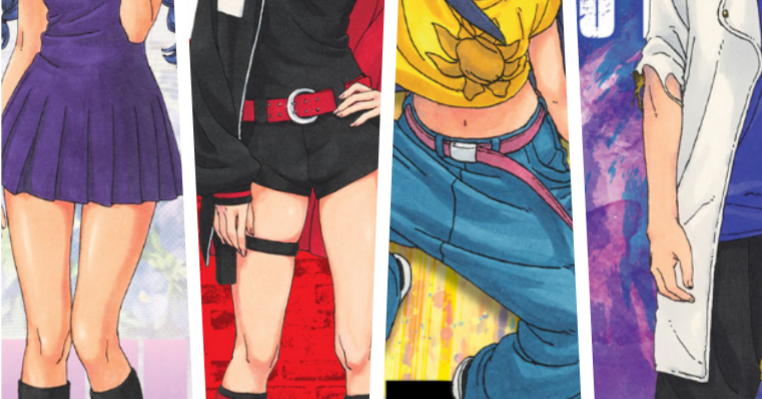Character Design in Boruto: Y2K
What does Y2K have to do with the Boruto series? More than you think.

Boruto: Two Blue Vortex (TBV) is a series laden with subtext. From the Shinju as an allegory for artificial intelligence (AI) to Eida as the ultimate influencer, manipulating others while simultaneously being trapped by her own powers, there's much going on beneath the surface in a story about brothers clashing over the fate of the shinobi world.
As the creator responsible for the art and tasked with writing the series under Masashi Kishimoto's auspices, Mikio Ikemoto tells a layered story through visual components as well as the narrative itself. One of Kishimoto's longest-serving assistants, Ikemoto's work on character designs for the franchise goes back as far as his design of the characters Zabuza and Haku in the first arc of Naruto. As he took the artistic reins in Boruto: Naruto Next Generations (NNG), we saw him steer the series away from the designs of the shinobi world that Kishimoto created, into a modern era represented by modern clothing, showcasing the changing times though the fashion choices of a new generation.
However, after the time skip into TBV, yet another shift occurred in character designs, especially for the human cast. Instead of simply having a modern feel, Ikemoto has been leaning heavily into Y2K (the year 2000 era) aesthetics, invoking fashion trends established at the end of the 20th century.
While this coincides with a resurgence in Y2K fashion in the 2020s, I believe this choice is more deliberate based on themes in the story that were prevalent during Y2K and how the style choices themselves are more representative of style at the end of the 20th century than modern aesthetics. (For further reading, check out these Millennials complaining about the lack of belts in the 2020s Y2K fashion revival.) From his fashion-icon cover art to his intricate character designs to his own statements about style and what inspires him, Ikemoto is aware of the context behind the visual statements made by what characters wear to be aware of what he's invoking with his clothing choices.
Why Y2K?
Without understanding the historical context of Y2k, it's easy to dismiss the decision to rely on the fashion style of that era as an aesthetic preference. However, the turn of the century was an era marked by rapid technological change, similar to the developments that take place in the shinobi world between the end of Naruto and the beginning of NNG. All of human civilization had existed before the online era, yet in the span of a decade, we went from being an analog society to a digital one. Home internet became widely available in the late 1990s. By 2007, the connectivity that began through your phoneline became a wi-fi connected smartphone in your pocket.
At the same time, Y2k marked both the end of the century and the end of the millennia. Death cults and doomsday theories filled popular culture and current events as the 1990s wound down. Similar to Kawaki's words that the age of shinobi is over, the end of the 20th century both symbolically felt like the end of an era and was the end of an era, the last years before the online age changed how humans communicate, interact, and consume. It was the end of an era, even if it wasn't the end of the world.
In addition to the cultural existential crisis, the digital world that had begun to work its way into all facets of life brought with it another crisis: the Y2K bug. Developers who set the parameters for calendars managed limited memory space on early computers by using a two-digit calendar number to indicate the year, not planning for decades in the future when the 1900s would become the 2000s. Starting in the early 1990s, industry experts began raising red flags about possible technological glitches that would occur at the beginning of the next century, affecting critical aspects of society, from the financial industry to transportation, energy to defense. The belief in a world-wide system failure led many to stock up on food, water, and ammunition, fearing the worst.
As someone who remembers staying up until the end of 1999, there was a collective sigh of relief when the lights stayed on after the ball dropped in Times Square. While many view the panic as overblown, the reality is that $300 million dollars were spent to correct the date issue before problems occurred, and major industries updated their systems to become Y2K compliant.
In Boruto, we see technological language used to explain the power of the Otsutsuki, referring to Shinjutsu as the programming language of the gods, describing karma as a compressed file, downloading into a vessel's body, the overwriting of memory as though it's simply a save file, as well as the tech-inspired names for new characters—Eida, Code, Bug, Daemon. We can view the creation of the Shinju themselves as an error in the Code, a decision inadvertently made that is leading to disaster. It's also possible to imagine that Omnipotence itself might later be viewed as nothing more than a glitch that occurred in reality, an error easily corrected without the public giving credit to the labor and sacrifice of people behind the scenes, putting in the effort to protect the collective memory of the world.
Of equal importance is considering Ikemoto's own influences for the series. In a an interview conducted for an event in France during the summer of 2024, Ikemoto cited The Matrix as a major source of influence. The first movie, released in 1999, was the culmination of many cultural and aesthetic elements of Y2K, combining retrofuturism with the cultural anxiety of a world taken over by computer-based machines, controlling and warping our perceptions of reality as humans serve the needs of machines rather than controlling them.
Let's take a look at a few of the clothing choices for specific characters and contextualize them in terms of Y2K culture.
Preppy vs Punk



The Craft (1996) and Clueless (1995) illustrating fashion choices for Sarada and Sumire's design.
The designs for Sarada and Sumire's clothing are showcase their differing personalities, the future conflict between their ideologies represented in their choices of clothing. Sumire is aligned with preppy fashion choices, collared shirts beneath jumpers and sweaters. Her sandal boots cling closely to her calves. The choice of tie seems professional and feminine, unlike the ironic loose ties worn by Avril Lavigne in the early 2000s.
In contrast, Sarada's look is somewhere on a spectrum between goth and punk. Her romper is hidden beneath a baggy jacket, her leggings making her sandals look more like combat boots. The jewelry accessories she chooses to wear are a marker of identity rather than one of status, chunky earrings bearing her clan's crest and a choker/dog collar, firmly pushing her look into the realm of an alt girl.
Sumire's outfit align with her current role in Konoha, working with the Scientific Ninja Tool team rather than being an active-duty shinobi. They also match with her more conservative approach to supporting Boruto, preferring a passive path to a risky one.
Sarada's clothing aligns with her individualistic perspective and her rebellion within Konoha. She combines feminine elements with a masculine jacket, representative of Boruto. Her style is purposefully meant to be brash, to make a statement to those viewing her that she won't be quiet. This matches her belief that the way to help Boruto is to seek him out rather than support him from the shadows, taking action rather than trusting him to handle things.
Kawaki as Counter Culture Mainstreamed



Kawaki's style borrows from several styles associated with violence and danger.
Kawaki's outfit at the beginning of TBV is a fascinating combination of elements from different fashion cultures: the belt from punk culture, sagging pants from hip-hop culture, and a trench coat reminiscent of fashion trends during the late 1990s that were vilified after the Columbine school shootings and media reports about the trench coat mafia.
Prevalent in Ikemoto's work, studded and riveted belts have been associated with counterculture movements since the 1950s, starting with rockers and later being adopted by the punk and goth communities. The tradition of studding belts started as a practicality for blue collar laborers to reinforce leather before being adopted by various rebellious subcultures. However, by the turn of the century, studded belts had moved into the mainstream, becoming a staple of Y2K culture with the spread of the pop punk and emo scenes.
One theory for the origin of baggy pants is that they came out of prison culture in the 1980s where inmates were not allowed to have belts. From there, the aesthetic spread and was soon associated with gang culture before entering the mainstream though hip hop. Before being popularized, the style of baggy pants was considered "dressing like a criminal." Similar to studded belts, baggy pants moved into popular culture and were widely worn in the Y2K era. In fact, torn hems, as seen in Kawaki's most recent outfit change, were a common element in the fashion scene at the turn of the century.
The trench coat plays a slightly different role in culture of the late 1990s. For several years, black trench coats had been a feature of the goth scene and were associated with alt culture. However, in the moral panic after the Columbine School shootings where the two boys who committed the murders called themselves part of the trench coat mafia, schools started outlawing trench coats and the fashion accessory became viewed with suspicion, associated with antisocial behavior. As the movie The Matrix, featuring black trench coats and automatic weapons, was released to popular acclaim the month before the shooting, it, too, was under scrutiny as something that might contribute to youth violence.
Three key elements of Kawaki's style been associated with rebellion, criminality, and violence, and they've all entered mainstream culture, perhaps an analogy to Kawaki himself: an outsider, a rebel, an attempted murderer who was integrated into Konoha through Omnipotence, erasing his initial origins and identity.
Sunflowers and Butterfly Clips




Baggy pants, chunky heels, chokers, the butterfly and sunflower aesthetic are ripped out of the pages of a Delia*s catalogue circa 1997.
I'd be remiss if I didn't compare the clothing choices for ChoCho and Himawari to the Delia*s catalogue aesthetic of the late 1990s. While butterflies and sunflowers are deeply associated with both characters, they were also popular themes of clothing for teen girls in the Y2K era, from butterfly hair clips to the sunflower in Blossom's hat. Other stylistic elements, such as jelly bracelets and chunky heels, pop up in many character designs as well.
What's significant about Himawari and ChoCho is that their clothing aligns with popular culture while both are affected by Omnipotence. Instead of making a statement, their clothing goes with the flow of popular culture. While Sarada, Kawaki, and Sumire are stuck reacting to Omnipotence, Himawari and ChoCho exist under the delusion plaguing the rest of the world, which is featured in their mainstream clothing choices.
What's Next?
This was such a fantastic topic to take a deep dive into (as the 37 open tabs in my browser will attest to). I really hope to do a part 2 of this focusing on the character designs of the Shinju and how they fit into camp fashion and perhaps another talking about the super hero and popular manga elements of many designs as well.
Thanks for reading!
